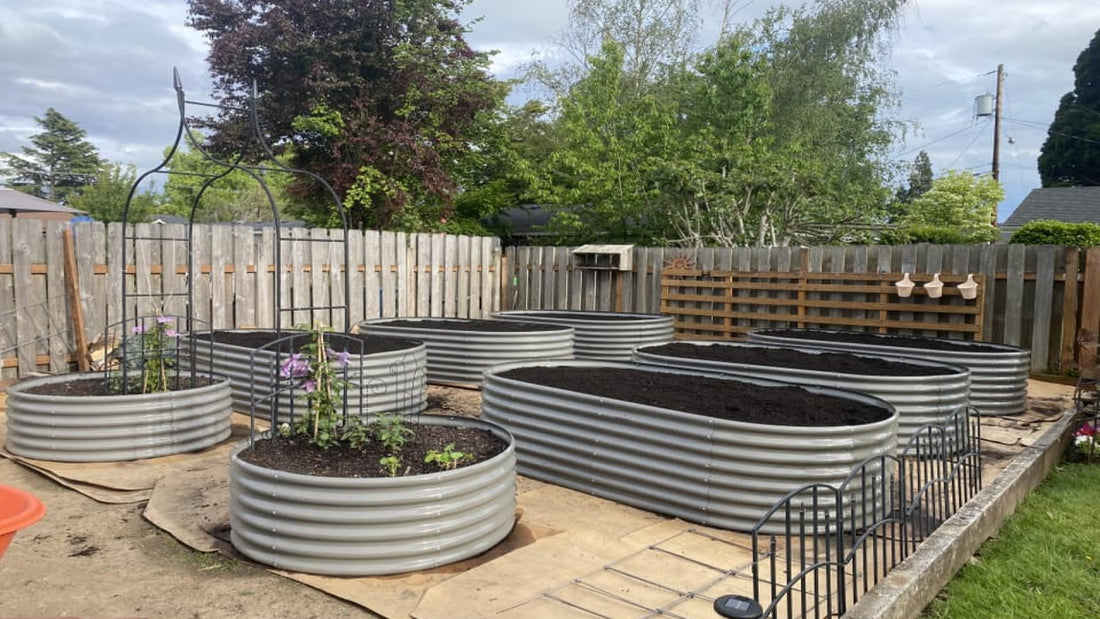Gardening in colder climates can be tricky, especially when you're working with raised beds. But don’t worry—there are plenty of hardy plants that not only survive the chill but actually thrive in it. From leafy greens to root vegetables, many cold-tolerant plants can brighten up your garden (and your meals!) even when the temperature drops. In this guide, we’ll walk you through ten tough plants that are perfect for raised beds in cool weather so you can enjoy fresh produce year-round.
1. Kale (Brassica oleracea var. sabellica)
Kale is an ideal winter vegetable, known for its cold tolerance and ability to become sweeter after frost exposure. This hardy, leafy green thrives in full sun but can also grow in partial shade, making it adaptable for various garden layouts. Harvesting the outer leaves regularly encourages continuous growth, ensuring a steady supply of fresh greens throughout the colder months.
2. Carrots (Daucus carota)
Carrots are perfect for raised beds, where soil conditions can be controlled to prevent common issues like forked roots caused by compacted soil. They thrive in deep, loose, well-drained soil—traits easily achieved in raised bed gardening. Carrots planted in late summer can be harvested in the fall, and with proper mulching, they can be stored in the ground through winter for extended harvesting.
3. Spinach (Spinacia oleracea)
Spinach is a quick-growing, cold-hardy, leafy green that can be planted in late summer for a fall harvest. Preferring full sun to partial shade, spinach thrives in moist, well-drained soil. To extend the harvest into winter, row covers, or cold frames can protect the plants from harsh frost, ensuring a continued supply of fresh spinach during colder months.
4. Leeks (Allium ampeloprasum)
Leeks, a cold-tolerant member of the onion family, are prized for their mild flavor. They require a long growing season and are best started from seedlings. Planting leeks in deep holes or trenches and gradually filling them with soil as they grow helps blanch the stems, resulting in the long, tender white shafts prized in culinary dishes. Their cold hardiness makes them a great choice for winter harvest.
5. Garlic (Allium sativum)
Garlic is typically planted in the fall, allowing time for the roots to establish before the ground freezes. It needs well-drained soil and full sun to thrive. Mulching after planting helps protect the bulbs during winter, while spring and summer offer the right conditions for growth. Garlic is harvested in mid to late summer, depending on climate and planting time.

6. Brussels Sprouts (Brassica oleracea var. gemmifera)
Brussels sprouts are incredibly cold-hardy, and their flavor improves after exposure to frost, making them a perfect winter vegetable. They require a long growing season, so they are best planted in early summer for a fall harvest. Since they can grow quite tall and the sprouts are heavy, staking the plants is important to prevent them from toppling over.
7. Collard Greens (Brassica oleracea var. acephala)
Collard greens are tough and resilient, thriving in cold temperatures and providing a continuous harvest throughout winter. They prefer full sun and fertile, well-drained soil. Regularly harvesting the lower leaves encourages new growth, extending the harvesting period and ensuring a steady supply of nutritious greens.
8. Parsnips (Pastinaca sativa)
Parsnips develop a sweeter flavor after exposure to frost, making them an excellent choice for winter harvesting. They need a long growing season, so planting them in early spring is ideal for a fall harvest. These root vegetables thrive in deep, loose soil, which is easy to achieve with raised garden beds, and they can withstand the cold, growing well into winter.
9. Winter Lettuce (Lactuca sativa)
Certain varieties of lettuce are bred for cold tolerance and can be grown in the fall and early winter months. These lettuce types prefer full sun to partial shade and well-drained soil. To protect them from severe frost and extend the harvesting season, cold frames or row covers are highly effective.
10. Mache (Valerianella locusta)
Mache, also known as corn salad, is a cold-hardy green that thrives in cool temperatures. It prefers full sun to partial shade and well-drained soil. Mache can be sown in late summer for a fall harvest or in early fall for an early spring harvest, as it tolerates frost well, making it a great option for extending the growing season into the colder months.

FAQs
How can I protect my raised bed plants during extreme cold snaps?
Using row covers, cold frames, or hoop houses over your raised beds offers excellent protection during sudden temperature drops. Adding an extra layer of mulch around the base of plants can also help insulate their roots. For delicate plants, portable cloches or even inverted buckets can shield them temporarily.
When should I plant cold-tolerant crops in my raised bed?
Planting times depend on the specific crop and your local climate. For fall and winter harvesting, plant cold-tolerant vegetables like kale, spinach, and garlic in late summer or early fall. If you aim for an early spring harvest, sow seeds of frost-hardy varieties in late fall before the ground freezes.
How do I water my plants in raised beds during the winter?
Watering frequency decreases during winter as plants grow more slowly and water evaporation is minimal. Monitor the soil moisture and water only when the soil is dry a few inches below the surface. Avoid overwatering, as wet soil combined with freezing temperatures can damage roots.
Are there specific fertilizers for cold-tolerant plants?
Most cold-tolerant plants benefit from a balanced, slow-release fertilizer applied at the start of the season. Leafy greens like kale and spinach prefer nitrogen-rich fertilizers, while root crops such as carrots and parsnips require phosphorus and potassium. Organic options, such as compost or manure, are excellent for winter crops.
Is it possible to grow perennial plants in raised beds in cold climates?
Many perennials, such as rhubarb and certain herbs (e.g., thyme or chives), are hardy enough to survive winter in raised beds. Ensure the soil is well-insulated with mulch, and consider using protective coverings to shield them from extreme cold.
What are the benefits of using raised beds for cold-tolerant plants?
Elevated garden beds offer better soil drainage, improved temperature control, and easier access for gardeners during cold seasons. They also warm up faster in spring, allowing for an earlier start to the growing season. These advantages make raised beds ideal for cultivating cold-hardy crops in challenging climates.

